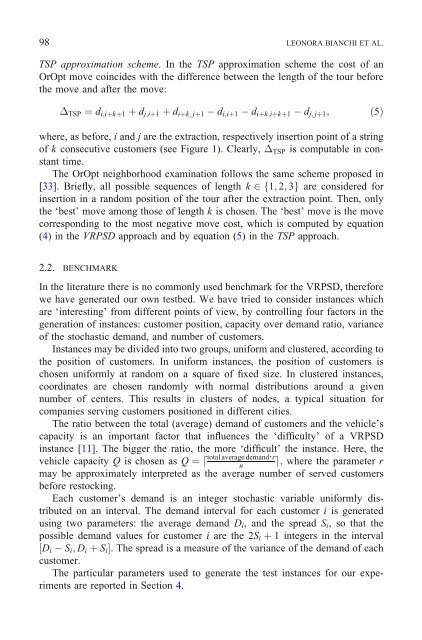Hybrid Metaheuristics for the Vehicle Routing Problem with ...
Hybrid Metaheuristics for the Vehicle Routing Problem with ...
Hybrid Metaheuristics for the Vehicle Routing Problem with ...
You also want an ePaper? Increase the reach of your titles
YUMPU automatically turns print PDFs into web optimized ePapers that Google loves.
98 LEONORA BIANCHI ET AL.<br />
TSP approximation scheme. In <strong>the</strong> TSP approximation scheme <strong>the</strong> cost of an<br />
OrOpt move coincides <strong>with</strong> <strong>the</strong> difference between <strong>the</strong> length of <strong>the</strong> tour be<strong>for</strong>e<br />
<strong>the</strong> move and after <strong>the</strong> move:<br />
TSP ¼ di;iþkþ1 þ dj;iþ1 þ diþk; jþ1 di;iþ1 diþk;iþkþ1 dj; jþ1; ð5Þ<br />
where, as be<strong>for</strong>e, i and j are <strong>the</strong> extraction, respectively insertion point of a string<br />
of k consecutive customers (see Figure 1). Clearly, TSP is computable in constant<br />
time.<br />
The OrOpt neighborhood examination follows <strong>the</strong> same scheme proposed in<br />
[33]. Briefly, all possible sequences of length k 2f1; 2; 3g are considered <strong>for</strong><br />
insertion in a random position of <strong>the</strong> tour after <strong>the</strong> extraction point. Then, only<br />
<strong>the</strong> Fbest_ move among those of length k is chosen. The Fbest_ move is <strong>the</strong> move<br />
corresponding to <strong>the</strong> most negative move cost, which is computed by equation<br />
(4) in <strong>the</strong> VRPSD approach and by equation (5) in <strong>the</strong> TSP approach.<br />
2.2. BENCHMARK<br />
In <strong>the</strong> literature <strong>the</strong>re is no commonly used benchmark <strong>for</strong> <strong>the</strong> VRPSD, <strong>the</strong>re<strong>for</strong>e<br />
we have generated our own testbed. We have tried to consider instances which<br />
are Finteresting_ from different points of view, by controlling four factors in <strong>the</strong><br />
generation of instances: customer position, capacity over demand ratio, variance<br />
of <strong>the</strong> stochastic demand, and number of customers.<br />
Instances may be divided into two groups, uni<strong>for</strong>m and clustered, according to<br />
<strong>the</strong> position of customers. In uni<strong>for</strong>m instances, <strong>the</strong> position of customers is<br />
chosen uni<strong>for</strong>mly at random on a square of fixed size. In clustered instances,<br />
coordinates are chosen randomly <strong>with</strong> normal distributions around a given<br />
number of centers. This results in clusters of nodes, a typical situation <strong>for</strong><br />
companies serving customers positioned in different cities.<br />
The ratio between <strong>the</strong> total (average) demand of customers and <strong>the</strong> vehicle’s<br />
capacity is an important factor that influences <strong>the</strong> Fdifficulty_ of a VRPSD<br />
instance [11]. The bigger <strong>the</strong> ratio, <strong>the</strong> more Fdifficult_ <strong>the</strong> instance. Here, <strong>the</strong><br />
vehicle capacity Q is chosen as Q ¼d<br />
total average demand r<br />
n<br />
e; where <strong>the</strong> parameter r<br />
may be approximately interpreted as <strong>the</strong> average number of served customers<br />
be<strong>for</strong>e restocking.<br />
Each customer’s demand is an integer stochastic variable uni<strong>for</strong>mly distributed<br />
on an interval. The demand interval <strong>for</strong> each customer i is generated<br />
using two parameters: <strong>the</strong> average demand Di, and <strong>the</strong> spread Si, so that <strong>the</strong><br />
possible demand values <strong>for</strong> customer i are <strong>the</strong> 2Si þ 1 integers in <strong>the</strong> interval<br />
½Di Si; Di þ SiŠ. The spread is a measure of <strong>the</strong> variance of <strong>the</strong> demand of each<br />
customer.<br />
The particular parameters used to generate <strong>the</strong> test instances <strong>for</strong> our experiments<br />
are reported in Section 4.
















